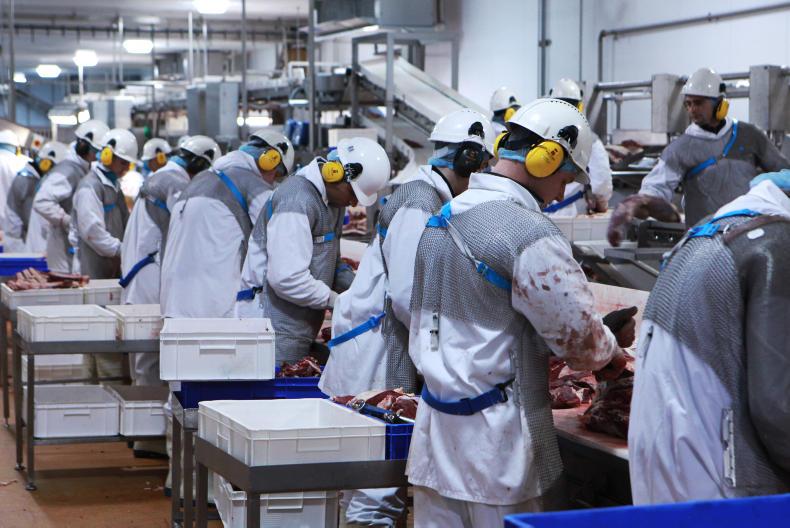Despite an increased availability of UK beef in the British market in 2018, imports of non-UK beef are also up, leaving the finely balanced beef trade working against farmers at present.
Slaughter statistics to the end of October 2018 show that 2.226m adult cattle have been slaughtered across the UK, which is 2.1% (or nearly 50,000 head) more than in the same period in 2017.
The increase has been mainly driven by cow slaughterings, which are up 6.8% to over 550,000.
In England and Wales cow slaughterings are up 9.1%. In Northern Ireland (NI) the increase is 3.8%. Only in Scotland are the figures actually down, in this case by 3.5%.
Outside of Scotland, the increase in cow slaughterings is mainly coming from dairy farmers culling cows in response to summer drought and higher costs this winter. It means supplies of manufacturing beef are plentiful at present and prices are under pressure.
The trade for prime beef is also being squeezed, mainly from imports of high-quality cuts destined for the foodservice trade.
The latest figures published by the Agriculture and Horticulture Development Board (AHDB) to the end of September 2018 show beef imports into the UK are up 6.6% on the same period in 2017.
The total to this point stood at 212,337t, and is the highest seen for over 10 years (data going back to 2006).
The Republic of Ireland remains the main source of imported beef, accounting for 71.3% of UK imports. It has also managed to increase market penetration this year, with imports up 8.4% on 2017 levels.
The Netherlands and Poland are next, with about 6% market share each, although imports from both countries are down on 2017.
Non-EU beef imports into the UK are relatively small, accounting for under 6% of the total. The biggest non-EU importer is Brazil, with 2,723t imported to September 2018, which is nearly double the same figure from 2017.
The UK also exports beef, roughly a third of the import total. Nearly 90% goes to other EU countries, and more than half of all exports are to the Republic of Ireland and the Netherlands combined.
Consumption
With slaughterings and beef imports both up, the third factor having a negative impact on farmgate prices is consumption.
During the 12 weeks to 4 November 2018, figures from market research firm Kantar Worldpanel show that retail sales of fresh and frozen beef decreased in volume by 2.5% compared with the same period in 2017.
There are numerous factors that drive consumption and in recent weeks the industry has been subjected to negative media reporting linked to the role of cattle in climate change.
However, figures from AHDB also show that the average retail price of beef is 10p/kg higher in October 2018 than in 2017, which inevitably will hit sales.
Read more
McDonald's to cut antibiotics in beef
No good news in beef outlook
Despite an increased availability of UK beef in the British market in 2018, imports of non-UK beef are also up, leaving the finely balanced beef trade working against farmers at present.
Slaughter statistics to the end of October 2018 show that 2.226m adult cattle have been slaughtered across the UK, which is 2.1% (or nearly 50,000 head) more than in the same period in 2017.
The increase has been mainly driven by cow slaughterings, which are up 6.8% to over 550,000.
In England and Wales cow slaughterings are up 9.1%. In Northern Ireland (NI) the increase is 3.8%. Only in Scotland are the figures actually down, in this case by 3.5%.
Outside of Scotland, the increase in cow slaughterings is mainly coming from dairy farmers culling cows in response to summer drought and higher costs this winter. It means supplies of manufacturing beef are plentiful at present and prices are under pressure.
The trade for prime beef is also being squeezed, mainly from imports of high-quality cuts destined for the foodservice trade.
The latest figures published by the Agriculture and Horticulture Development Board (AHDB) to the end of September 2018 show beef imports into the UK are up 6.6% on the same period in 2017.
The total to this point stood at 212,337t, and is the highest seen for over 10 years (data going back to 2006).
The Republic of Ireland remains the main source of imported beef, accounting for 71.3% of UK imports. It has also managed to increase market penetration this year, with imports up 8.4% on 2017 levels.
The Netherlands and Poland are next, with about 6% market share each, although imports from both countries are down on 2017.
Non-EU beef imports into the UK are relatively small, accounting for under 6% of the total. The biggest non-EU importer is Brazil, with 2,723t imported to September 2018, which is nearly double the same figure from 2017.
The UK also exports beef, roughly a third of the import total. Nearly 90% goes to other EU countries, and more than half of all exports are to the Republic of Ireland and the Netherlands combined.
Consumption
With slaughterings and beef imports both up, the third factor having a negative impact on farmgate prices is consumption.
During the 12 weeks to 4 November 2018, figures from market research firm Kantar Worldpanel show that retail sales of fresh and frozen beef decreased in volume by 2.5% compared with the same period in 2017.
There are numerous factors that drive consumption and in recent weeks the industry has been subjected to negative media reporting linked to the role of cattle in climate change.
However, figures from AHDB also show that the average retail price of beef is 10p/kg higher in October 2018 than in 2017, which inevitably will hit sales.
Read more
McDonald's to cut antibiotics in beef
No good news in beef outlook






 This is a subscriber-only article
This is a subscriber-only article









SHARING OPTIONS: